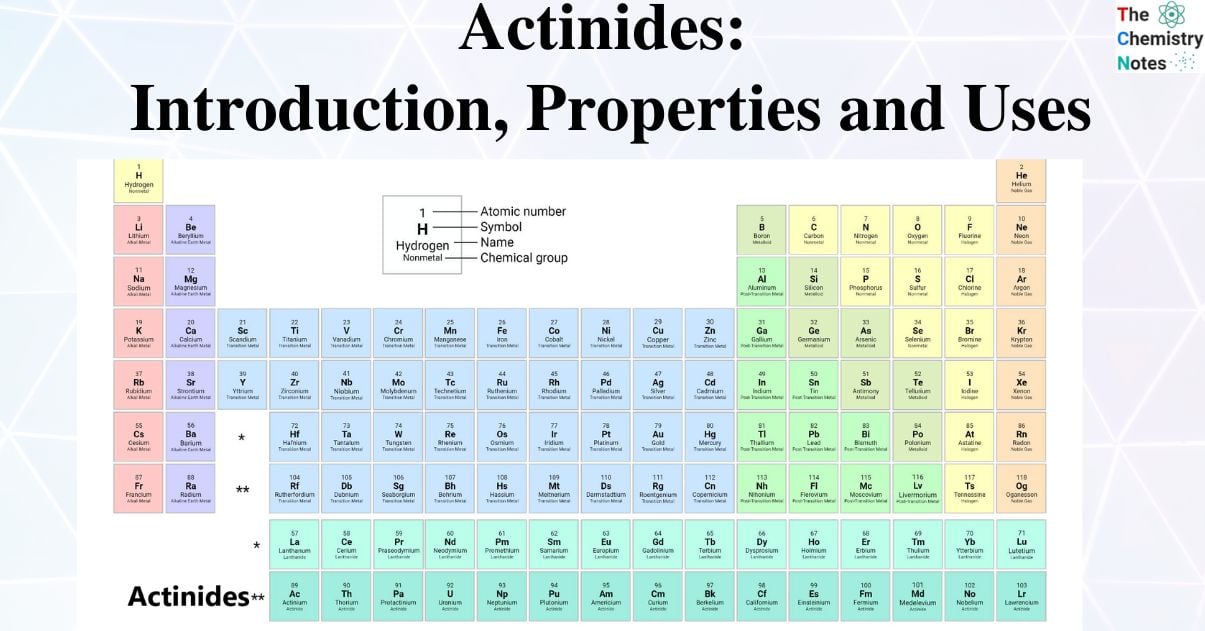

Actinides are a group of fifteen metal elements with atomic numbers ranging from 89 to 103. The name of the series is derived from actinium, the element that appears at the start of the series. Chemically, each member of the series is similar to the others.
Both the Actinide Series and the Lanthanide Series are referred to as Rare Earth Metals. These substances are all radioactive and have a wide range of oxidation numbers. The most prevalent and well-known element is uranium, which is transformed into plutonium through a nuclear reaction and utilized as nuclear fuel.

Table of Contents
Interesting Science Videos
Actinides are elements with atomic numbers ranging from 90 to 103, which come after the element Actinium. They include eleven transuranic elements, or those created artificially through nuclear reactions, as well as naturally occurring forms of thorium, protactinium, and uranium. All actinides, however, are radioactive.
The Actinides series consists of the following 15 elements: Actinium (Ac), Thorium (Th), Protactinium (Pa), Uranium (U), Neptunium (Np), Plutonium (Pu), Americium (Am), Curium (Cm), Berkelium (Bk), Californium (Cf), Einsteinium (Es), Fermium (Fm), Mendelevium (Md), Nobelium (No), and Lawrencium (Lr).
Actinides are a class of elements with similar properties to lanthanides. Transuranium elements, which appear after uranium in the periodic table, and transplutonium elements, which appear after plutonium, are two overlapping families of actinides.
Enrico Fermi hypothesized the presence of transuranium elements in 1934 based on his experiments. Even though there were four actinides known at the time, it wasn’t yet known that they belonged to the same family as lanthanides.
Uranium and thorium were the first actinides to be found, by Klaproth in 1789 and Berezelius in 1829, respectively. However, the majority of actinides were created by humans in the 20th century. Small amounts of actinium and protactinium can be discovered in nature as breakdown products of 253- and 238-uranium. Plutonium is created in minute quantities naturally by the neutron capture process of uranium. The main source of thorium ore is monazite. It is a phosphate ore with significant Lanthanide content. Due to its appearance as masses of dark, pitch-like material, the primary uranium ore, U3O8, is also known as pitchblende. Beyond uranium, all elements are synthetic. Because many actinides are radioactive, they must be handled carefully.
The most prevalent actinides in nature are uranium and thorium, with mass concentrations of 16 ppm and 4 ppm, respectively.
The majority of uranium is found in the Earth’s crust as a combination of its oxides in the mineral uraninite, often known as pitchblende due to its dark hue.
There are a large number of other uranium minerals, such as
The three isotopes that make up natural uranium are:
The most abundant thorium minerals are:
Only about 5* 10 -15 % of the Earth’s crust contains actinium. Although it is found in considerably lesser amounts in other minerals, actinium is mostly found in uranium-containing minerals. Samples of lunar soil did not contain any traces of plutonium. The majority of plutonium is created synthetically due to its rarity in nature.
| Element | Symbol | Atomic Number | Atomic Mass (amu) |
| Actinium | Ac | 89 | 227 |
| Thorium | Th | 90 | 232 |
| Protactinium | Pa | 91 | 231 |
| Uranium | U | 92 | 238 |
| Neptunium | Np | 93 | 237 |
| Plutonium | Pu | 94 | 244 |
| Americium | Am | 95 | 243 |
| Curium | Cm | 96 | 247 |
| Berkelium | Bk | 97 | 247 |
| Californium | Cf | 98 | 251 |
| Einsteinium | Es | 99 | 252 |
| Fermium | Fm | 100 | 257 |
| Mendelevium | Md | 101 | 258 |
| Nobelium | No | 102 | 259 |
| Lawrencium | Lr | 103 | 262 |
The actual position of actinides in the periodic table is group number 3 and period number 7. In the seventh period, the electrons are preferentially filled in the inner 5f subshell. The fourteen elements following actinides (Th to Lr) show similar chemical properties.
Hence, they are grouped and placed at the bottom of the periodic table with a general electronic configuration: [Rn] 5f 2-14 6d 0-2 7s 2
Actinides have the following characteristics:
| Element | Configuration |
| Actinium | [Rn] 6d 1 7s 2 |
| Thorium | [Rn] 6d 2 7s 2 |
| Protactinium | [Rn] 5f 2 6d 1 7s 2 |
| Uranium | [Rn] 5f 3 6d 1 7s 2 |
| Neptunium | [Rn] 5f 4 6d 1 7s 2 |
| Plutonium | [Rn] 5f 6 7s 2 |
| Americium | [Rn] 5f 7 7s 2 |
| Curium | [Rn] 5f 7 6d 1 7s 2 |
| Berkelium | [Rn] 5f 9 7s 2 |
| Californium | [Rn] 5f 10 7s 2 |
| Einsteinium | [Rn] 5f 11 7s 2 |
| Fermium | [Rn] 5f 15 7s 2 |
| Mendelevium | [Rn] 5f 13 7s 2 |
| Nobelium | [Rn] 5f 14 7s 2 |
| Lawrencium | [Rn] 5f 14 6d 1 7s 2 |
Actinides show variable oxidation states because of the smaller energy gap between 5f, 6d, and 7s orbitals. Other oxidation states are possible despite the fact that 3+ is the most stable oxidation state due to the efficient shielding of f-electrons.
The maximal oxidation state initially rises until about halfway through the series, after which it falls; for example, it rises from +4 for Th to +5, +6, and +7 for Pa, V, and Np but falls for the next elements.
Actinides are more reactive and electropositive than lanthanides due to the lower ionization energy. They react with hot water. When exposed to oxidizing chemicals, it forms a passive coating. create hydrides and halides. Actinides are potent reducers. Because they are less ionized in energy than lanthanides, actinides are thought to be electropositive and more reactive. Actinides begin to react when placed in hot water. Usually, when they come into contact with an oxidizing chemical, they develop a passive coating. Halides and hydrides then follow. The best illustration of efficient lowering agents are actinides.
Only americium and thorium are not thought to be very high-density actinides. One of the actinides, the lanthanides have a far greater melting point than the others but no boiling point.
Similar to lanthanides, actinides also feature ions with unfilled orbitals and f-orbital electrons. The f-f electron transition creates a visible color when a specific frequency of light is absorbed.
Ions with 2 to 6 electrons in 5f-orbitals show color in aqueous solution as well as crystalline structures. The color is provided via the f-f transition. The majority of actinide ions are colored.
The quantity of electrons in 5f-orbitals affects the color of the ions. The ions with zero 5f-orbital electrons (i.e., 5f 0 ) or seven 5f-orbital electrons (i.e., 5f 7 ) are colorless.
The colored ions in different charges are shown in the below table:
| Ions | Inner configuration | Ccolour |
| Th 4+ | 5f 0 | Colourless |
| U 3+ | 5f 3 | Red |
| Np 3+ | 5f 4 | Purple |
| Pu 3+ | 5f 5 | Vilot |
| Am 3+ | 5f 6 | Pink |
| Cm 3+ | 5f 7 | Colourless |
| U 4+ | 5f 2 | Green |
| Np 4+ | 5f3 | Yellow green |
Actinides are marginally more likely to produce complex compounds than lanthanides. Their smaller ions and higher charge are what cause this.
The majority of the actinide halides form complex combinations when they interact with alkali metal halides.
Chelates are created when actinides react with organic compounds like oxime and EDTA.
For the ions M 4+ , MO2 2+ , M 3+ ,and MO 2+ the degree of complex formation declines in the order.
M 4+ > MO2 2+ > M 3+ > MO 2+ .
About Author
Jyoti Bashyal, a graduate of the Central Department of Chemistry, is an avid explorer of the molecular realm. Fueled by her fascination with chemical reactions and natural compounds, she navigates her field's complexities with precision and passion. Outside the lab, Jyoti is dedicated to making science accessible to all. She aspires to deepen audiences' understanding of the wonders of various scientific subjects and their impact on the world by sharing them with a wide range of readers through her writing.